All About Birds Pg 3
Waterfowl
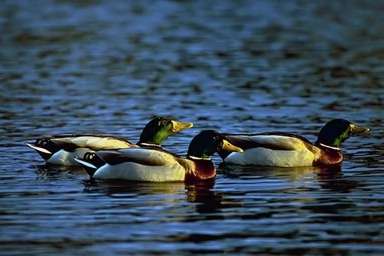
mallard ducks
From Daffy Duck to Mother Goose, waterfowl seem to be
some of the most popular birds to turn into cartoon characters.
Perhaps it's the oversized bills, the nasal QUACK/HONK or the slight
waddle in the walk that make these birds such a fond part of children's
literature and television. Whatever the attraction, these ugly
ducklings have been turning into swans for generations.
The main characteristic of ducks, geese and swans (known as waterfowl) is that they all love to swim. Although they have somewhat different diets, they all spend a lot of time in the water. Ducks and swans dip, duck and dive to get at insects, snails, small fish and water plants. Geese mainly graze on land in fields and meadows eating plants, grass and seeds.

mute swan (trumpeter swans have black bills,
mute swans have orange bills)
When they aren't in the water, waterfowl waddle their way through life.
Swans and most ducks are clumsy and awkward on land. Some kinds of ducks can barely walk at all, and hardly ever leave the water. Geese are a bit better at walking, since they spend a lot of time feeding on land, but you can still make out the waddle if you watch them for awhile.
Those awkward legs are great in the water though. The legs are quite far apart and the feet are webbed which makes waterfowl a graceful group of swimmers.

redhead duck
With a Quack, Quack here and a Meow, Meow there?
Ducks say "quack". Geese and swans say "honk"... right?
Well, for the most part that is true, but although many geese do honk and most ducks do quack, others make altogether different sounds.
Some geese cackle and cluck like hens and chickens. Some ducks squeal, squeak and cluck. And a male Redhead Duck MEOWS like a cat.
... I'll bet that confuses the other birds in the marsh!
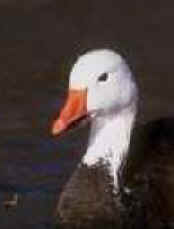
Bills, bills, bills
When we spoke about raptors, we noted that their beaks were hooked and pointed for tearing flesh.
Waterfowl have very different beaks (or bills). They are flat and rounded. Perfect for rooting around in soft marsh soil for plants and small animals

geese
Of all the cute images of waterfowl you'll find in books and cartoons, the image of mom followed by a row of little waddling goslings (or ducklings) is the cutest.
Most waterfowl build their nests near the water's edge. Though there are some ducks that make their nests in trees or holes in the ground.
Baby waterfowl hatch with their eyes open and can walk and swim right away. While the babies are growing up, first one parent and then the other molts or sheds the long wing and tail feathers. While they are molting, the parent cannot fly. But by the end of summer, both parents have grown new feathers as have the young ones, so they are all able to migrate together.
And that brings us to the last characteristic of waterfowl -- most of them migrate. They form flocks (or groups) of birds and form familiar patterns in the sky. Some like the Canada Geese, fly in a pattern shaped like a V. Others such as Black Brants fly in a single slanting line.
Although these patterns may seem odd, they have a very important purpose. The first goose in line pushes through the air and makes a path for the others. It really does make it easier for the others to fly! When the leader gets tired, it drops back and another moves up to take its place!
Mallard Duck:
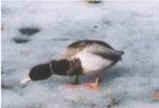


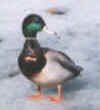
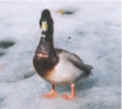
Scientific information: Waterfowl make up the scientific "order" Anseriformes. Within this order are the "families" Anhimidae and Anatidae -- most of the waterfowl fall into the second family.
Take
a Break!
On-Line Activity:
Duck
Shooting Gallery